|
|
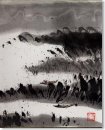
|
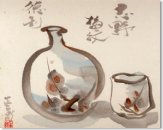
|

|
|
Kato Kozo
|
Hayashi Shotaro
|
Nishioka Koju
|
|
Many a potter is equally adept with a calligraphy brush as with a wheel. When I was writing my book Yakimono Sanka I asked quite a few potters to help out with illustrations on the theme of sake utensils. Almost everyone I asked sent me something, much to the astonishment of my publisher.
A square writing board in Japan is called a shikishi and they are used for autographs, as well as for small drawings. If you've ever been to a famous restaurant here you might have seen them hanging on the wall with the signatures of all the famous patrons.
Quite a few potters and other artists sent me shikishi. The great Mino potter Kato Kozo sent a very Zen-like drawing of a man on a small boat while his neighbor Hayashi Shotaro sent a Shino plum-design tokkuri (sake flask) and guinomi (sake cup) shikishi. See the above photos. Much further down the coast from Karatsu came a simple drawing by Nishioka Koju of two guinomi and a tokkuri; very much in tune with Karatsu's understated underglaze iron paintings. Again, see above photo.
One non-potter Yataiki sent in a fabulous ink painting of tawara-rice-bale-shaped tokkuri and guinomi with the writing saying hodo-hodo (meaning "in moderation"). Now if I could only follow that advice!
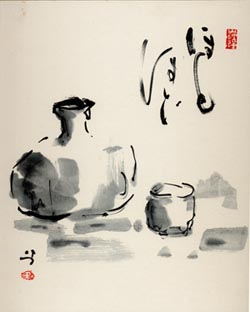
Calligraphy/Drawing by Yataiki
On sheets of paper came many works. An instructive drawing by Kishimoto Kennin explains the keshiki (landscape) on Iga works, showing the natural ash glaze, the white nuka area, and the stone bursts.
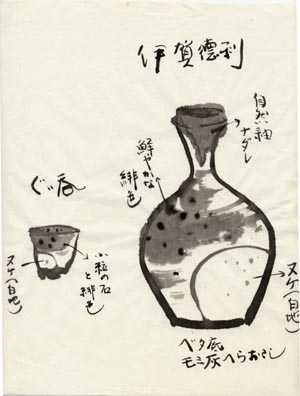
Calligraphy/Drawing by Kishimoto Kennin
Two graceful tokkuri were sent in, one of a mountain landscape by Tsuji Seimei and the other of a traditional Oribe piece by Takiguchi Kiheiji.
|

|

|
|
Tsuji Seimei
|
Takiguchi Kiheiji
|
|
A playful work came in from the Mashiko brush of Takauchi Shugo. He writes, "All the folks who make sake are good people, and all the folks who make sake utensils are good people." I'd have to agree.

Calligraphy by Takauchi Shugo
Classical drawings of a Ki-Seto tokkuri and guinomi from Suzuki Goro, of Oribe works by Matsuzaki Ken, Korean Yi Dynasty pieces by Kobayashi Togo, and three Bizen pieces by Okada Teru also found their way into the book.
|
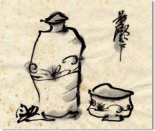
|
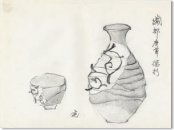
|
|
Suzuki Goro
|
Matsuzaki Ken
|
|
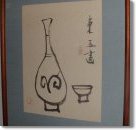
|
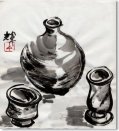
|
|
Kobayashi Togo
|
Okada Teru
|
|
Tsujimura Shiro offered calligraphy for the word play (asobi) -- see below.
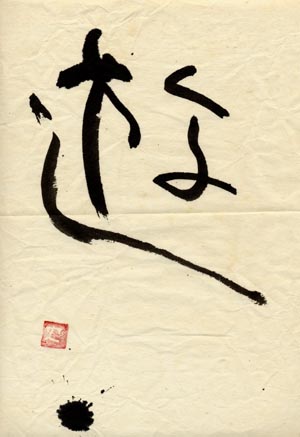
Calligraphy by Tsujimura Shiro
And just recently a rare shikishi was hung on my office wall (see below photo). It is from the hand of the late great scholar-potter Koyama Fujio. You can read about him
by clicking here.
The ink is rather light and the brush work is spontaneous and flowing. On the bottom left corner is his artist's name, Kozanshi. The calligraphy itself reads genmyo and what a wonderful meaning it has -- "wondrous profundity, esoteric, mysterious."
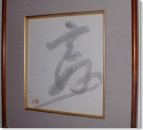
Calligraphy by Koyama Fujio (click for larger image)
I like the shikishi so much I seem to have become reflected in it!
The works I offer on japanesepottery.com are also a reflection of the genmyo that can exist in our living areas if we choose to place in them things which are wholesome, natural, and vibrant. A fine piece of pottery or calligraphy is there to help enlighten our souls. I'm honored to be able to share these works in ink with you.
LEARN MORE
For more photos and details on calligraphy,
please visit this outside site.
|